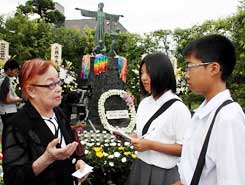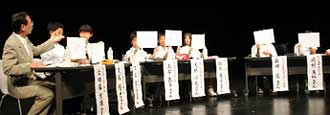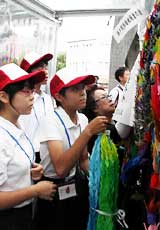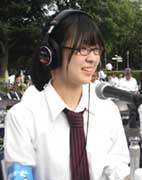Two junior writers experience peace exchange
in Nagaoka, Niigata Prefecture
Two junior writers, both 3rd-year students in junior high school, visited the city of Nagaoka in Niigata Prefecture from July 31 to August 3. They were invited by Nagaokaminami Junior High School, which plans to have its students travel to Hiroshima next spring on a school trip. The junior writers attended an event to comfort the souls of the victims of an air raid attack in Nagaoka during World War II and floated paper lanterns for this purpose. They also took part in a peace forum organized by the city of Nagaoka as well as a gathering where they interacted with students of Nagaokaminami Junior High School and shared their ideas about peace.
| August 1 | Gathering in the "non-nuclear peace city" of Nagaoka |
| Air raid in August 1945 killed 1,480 people "Mock atomic bomb" was dropped on the city during the war |
|
 |
| After the gathering, Mako and Masaya (right) listen to Ms. Shichiri (left) describe her experience of the air raid. |
The city of Nagaoka was bombed in an air raid that took place on the night of August 1, 1945. Some 80% of the urban area was burned, and about 1,480 people died. On the morning of August 1, we attended a gathering of citizens in the "non-nuclear peace city" of Nagaoka. The gathering was held in Peace Forest Park in the city center. After an offering of flowers and a silent prayer, Ai Shichiri, 86, a survivor of the air raid, shared her account of the attack.
Ms. Shichiri managed to escape to the river that flows through the city, but her daughter Michiko, just a year and a half old, died. "I took on my daughter's life," Ms. Shichiri told us, "so I'm able to meet you here today. We must never forget what happened in Nagaoka."
That night, we floated paper lanterns on the river to comfort the souls of the victims of the air raid. On my lantern, I wrote the message: "We don't need nuclear power anymore." Because of the accident at the nuclear power plant in Fukushima, I no longer trust the use of nuclear energy.
During this visit, we became aware of a link between Nagaoka and the cities of Hiroshima and Nagasaki. At 8:13 in the morning on July 20, 1945, a "mock atomic bomb" was dropped by the U.S. army on Nagaoka. At the time, the United States was planning to drop an atomic bomb on the city of Niigata, so they chose nearby Nagaoka. The shape of the bomb was similar to the atomic bomb dropped on Nagasaki, but inside the bomb was gunpowder instead of plutonium. As a result, four people were killed and five others were injured. About two weeks after this trial run, the real atomic bombs were dropped on Hiroshima and Nagasaki. Near City Hall in Nagaoka is a monument to mark the site where the "mock atomic bomb" fell. (Masaya Obayashi, 14)
| August 1 and 2 | Discussing peace at a "peace forum" and Nagaokaminami Junior High School |
| Searching for "what we can do" | |
 |
On August 1, the Nagaoka Peace Forum was held at a hall in the city. The two of us joined five junior high school students from Nagaoka to discuss our ideas about peace = photo.
Keiko Kishimoto, 14, a 2nd-year student at Nagaokaminami Junior High School, posed the question: "With 100 points a perfect score, how would you rate the state of peace in the world?" My fellow junior writer, Masaya Obayashi, answered "0 points," arguing that "Even if 99% of the whole world is at peace, if 1% of the world is suffering from conflict or war, we can't overlook that." I answered "30 points" and pointed to such problems in the world as terrorism and refugees, and in Japan people have had to flee their hometowns as a result of the accident at the nuclear power plant in Fukushima.
Another participant of the forum, Kaoru Morita, 14, who attends the Nagaoka junior high school attached to Niigata University, asked the question: "What should we do to raise the awareness of peace in Nagaoka?" I answered, "It's important to gain knowledge and take action in cooperation with others." Offering an example, I added, "I can learn about what happened in Hiroshima and Nagaoka during the war and convey what I learn to my friends. Then, working together, we can help raise other people's awareness of peace."
 |
| Junior high school students from Nagaoka offer paper cranes at the Children's Peace Monument. |
The next day, at Nagaokaminami Junior High School, we talked about peace issues with four 2nd-year students. On the subject of "whether or not armed forces are needed," we got into a lively debate. Five of the six participants, with me being the exception, insisted that an armed force is needed to protect Japan from attack by other nations. But I was able to gain the sympathy of some of them by contending that "There shouldn't be any armed forces in the world at all. Conflicts should be settled through dialogue, not through force." (Mako Sakamoto, 14)
| August 6 | Nagaoka junior high school students attend Hiroshima Peace Memorial Ceremony |
| Make an offering of 4,500 paper cranes | |
Twenty-three junior high school students from Nagaoka traveled to Hiroshima to attend the Peace Memorial Ceremony held on August 6. The city of Nagaoka organized the trip to offer the students an opportunity to reflect on the cruelty of war and the importance of peace.
Prior to the ceremony, the group presented about 4,500 paper cranes made by Nagaoka elementary school students to the Children's Peace Monument. At the ceremony they listened closely to the remarks made by Kazumi Matsui, the mayor of Hiroshima, and others. Misa Okamura, 13, a 2nd-year student at Nagaoka Junior High School, said with conviction: "It made me feel that human beings can abolish war and nuclear weapons. The atomic bomb was horrific and a tragedy like that should never be repeated." (Masaya Obayashi, 14, who served as the photographer, too)
 Kana Kumagai talks on the radio program at Peace Memorial Park. |
Representing "Peace Seeds," I was a guest on a radio program by FM Chupea, which was broadcast live from the site of the Peace Memorial Ceremony. The program lasted about an hour. The host asked my impression of the "Commitment to Peace" read out by two children from Hiroshima. To me, the most impressive words concerned "the power of human beings" to provide mutual support and convey the importance of peace to one another so I responded, "Like these elementary school students, students in junior high and high school are also determined to do our best for peace." At the end of the program, I shared this message: "During the ceremony, I was struck by the thoughts and wishes for peace of the speakers and felt moved to reflect on these ideas. I think there's more that Hiroshima can do to promote peace in the world." (Kana Kumagai, 16) |
|
Click to read the feature article "August 6, 2011: Messages on paper cranes.">>>
|